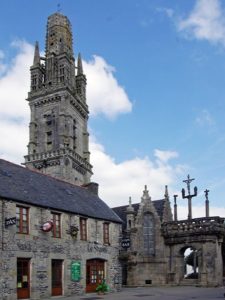Lampaul-Guimiliau is on the ‘must see’ list of Parish Closes. The wealth came from linen and tanning. The Close is surrounded by a low wall and triumphal arch which has a balustrade and small calvary on top.
Next to it is the 17thC Chapelle funéraire, with round doorway and beautifully carved door with a representation of the tree of Jesse. Above the windows are columns and blind niches.
The calvary in the churchyard has the crucified Christ with the two robbers. Two angels below Christ are collecting his blood. On the reverse side is a carving of the Virgin with the body of Christ.
The church tower has an archway through which the road would have run. The Spire was one of the highest in Brittany until it was struck by lightning in 1809. It is now left as a short and stubby stump.
The south porch is dated 1533, capped with pinnacles. Inside are carvings of the twelve Apostles. There is a carving of the Virgin and Child above the twin doors. It has a highly carved ceiling with bosses and a stoup.
Inside the church, pillars support pointed arches. The walls are white and have a decorative carved wooden frieze. The lime washed wooden ceiling has wooden ribs. There are carved wooden beams across the roof. The side windows are modern with abstract designs in shades of pale yellows, browns, greens and whites.
A painted 16thC Holy Rood of Glory separates the choir from the nave. It has a carving of Christ on the cross with the Virgin Mary and St John. Below are a series of carvings of different scenes of the Passion of Christ from the Mount of Olives, the scourging, crowning with thorns, carrying the cross, crucifixion and the entombment. On the opposite side are scenes of the Annunciation.
The high altar is a small table with columns and a host box, with modern stained glass windows behind. On one side is a statue of St Peter with the keys of Heaven and St Paul on the other. In front is the small mass altar. There are four choir stalls on either side and a long wooden pew. There is a carved wood eagle lectern and a highly carved altar rail.
The main glory of the church are the other 17thC altars which all have huge, highly decorative painted retables. As well as the two major retables on either side of the high altar there are others on the side walls which include St Lawrence holding a grid iron. He was a 3rd century martyr who according to legend was roasted on a grid. There is also St Margaret who is shown trampling the dragon which had swallowed her. Satan in the shape of a dragon, tried to swallow her but she escaped alive when the cross she carried irritated the dragon's innards.
To the south side of the choir is the Retable of St John the Baptist. This stretches nearly to the ceiling and only a bit of the stained glass window peeps above it. It is a glorious display of carving and colour. The central panel shows five scenes from the life of John from his baptism of Jesus to Salome presenting his head to Herod. It is surrounded by highly carved pillars. On either side are further carvings including a scene of the fall of the Angels, a statue of John on the right and Michael slaying the dragon on the left. Above each of these are cherubs.
On the north side is the equally impressive Retable of the Passion. The central panel has gilt representations of Jesus washing the feet of the disciples and the last supper. Above are scenes from the Passion including the kiss of Judas, the scourging, carrying the cross, crucifixion, descent from the cross and entombment. To the left is a statue of St Miliau, the patron saint and below his martyrdom when he was beheaded by his brother. He can be seen holding his head. On the left is an unnamed bishop and below a beautiful carving of the birth of the Virgin Mary. St Anne is lying in a four poster bed being congratulated by St Joachim the proud father. The midwives are washing the newborn infant.
The pulpit is 18thC and has carved panels of the four evangelists and also the four doctors of the church (St Augustine, St Jerome, St Ambrose and St Gregory).
On the north wall is a 15thC carving from a single block of oak of the descent from the cross. It shows the women collecting the dead body of Christ prior to burial.
Above the west end of the church is a carved wood balcony with the organ. To one side is the font with carved canopy painted blue, red and gilt. It has finely carved pillars with a scene of the baptism of Christ and the twelve apostles above.
To the other side is a limestone carving of the entombment from 1676. Christ is lying on the tomb and surrounded by beautifully painted carvings including the Virgin Mary being comforted by St John and Mary Magdalene. There are two glass cases containing the processional banners. One has a picture of the Virgin and Child on one side and a sun burst on the other. The other has St Pol on one side and the risen Christ being crowned by God the Father and cherubs on the other.
Pictures of Lampaul-Guimiliau begin here: http://wasleys.org.uk/france/brittany_11/ab_wk3/46/image-html/11IMGP8990.html










